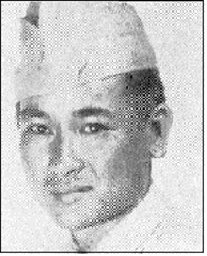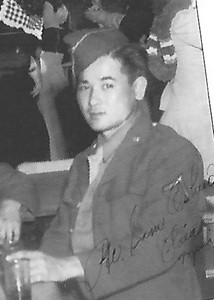
Sam Yasuichi Oshiro
Private First Class
442nd Regimental Combat Team
3rd Battalion, I Company
Sam Yasuichi Oshiro was born in Paia, Maui, Territory of Hawaii, on February 16, 1921. He was the eldest of three sons and four daughters of Yasukama and Kanamo (Asato) Oshiro, who emigrated from Okinawa Prefecture, Japan, in 1906 and 1910, respectively. They married on November 1, 1917, in Wailuku and worked as field hands for the sugar plantation in Paia.
Sam was educated at Paia School and Maui High School. In the 1940 Federal Census he was living with his family in School Camp, Paia. His siblings were: brothers Yasakichi and Yasunobu Roy; and sisters Akiko, Fumiko, Chiyoko, and Aiko.
Sam moved to Honolulu where he lived at 343 Pahala Lane and worked as a bellman at the Alexander Young Hotel – Mr. Quilan was his employer. When he registered for the draft on February 16, 1942, at Local Board No. 6, he listed his father in Paia as his point of contact. Sam was 5’3½” tall and weighed 120 pounds.
Sam Yasuichi Oshiro enlisted into the U.S. Army on March 25, 1943, in Honolulu. He was sent to the “tent city” nicknamed Boom Town, at Schofield Barracks with the other recruits. They were given a farewell aloha ceremony by the community on March 28 at Iolani Palace. On April 4, the new soldiers left on the S.S. Lurline for San Francisco enroute to Camp Shelby, Mississippi. Sam was assigned to 3rd Battalion, I Company, 3rd Platoon, 1st Squad.
After a year of training, the 442nd left Camp Shelby for Camp Patrick Henry, Virginia, on April 22, 1944. They shipped out to the Mediterranean Theater of Operations in a large convoy of troop ships on May 2 and arrived in Naples, Italy, on May 18.
Sam fought in the Rome-Arno Campaign, entering combat on June 16 near Suvereto. After fighting north up the Italian peninsula, the 442nd was sent to Marseilles, France, on September 27 to join in the Rhineland-Vosges Campaign.
On October 10, 3rd Battalion was moved by rail from the staging area in Septemes, just outside Marseilles, up the Rhone Valley north to the Vosges. The train was an assortment of “40 and 8” boxcars. They arrived in the assembly area at Charmois-devant-Bruyères at midnight on October 13. At 2:00 p.m. the next day the Combat Team began moving into position to attack the important road center of Bruyères the following morning.
After several days of intense fighting, the enemy had been cleared from the town and its surrounding hills, and on October 23 the 442nd was ordered to take the next town, Biffontaine. Finally on October 24 they were taken off the front lines and put in reserve in nearby Belmont for a rest after eight days of heavy fighting, little to no sleep, harsh weather conditions, and many casualties.
In the afternoon of October 26, the short rest was abruptly ended when the 442nd was ordered to go into the lines the next morning and fight through to rescue the 1st Battalion of the 141st (Texas) Infantry Regiment. After moving too fast and over-reaching its support, they had become surrounded on three sides by the enemy and were unable to extricate themselves. The 2nd and 3rd Battalions of the 141st Infantry, along with other units, had tried to rescue them, but were thrown back each time they attacked.
After four days of heavy fighting, on October 30 the 442nd had effected the rescue of the “lost battalion” of the 141st Infantry. The 3rd Battalion was then ordered to push on to the end of the long ridge that had been the initial objective. By the evening of October 31, they had cleared the ridge line of any organized resistance by the Germans.

The next day all units remained substantially where they were, holding defensive positions and patrolling to find out what the enemy’s dispositions were. Pfc. Sam Yasuichi Oshiro was killed in action by intense artillery fire on this day, November 1, 1944.
According to Pfc. Richard Masaichi Oshiro of Company I, “I didn’t see any of the 1st Squad boys. I found out they had been either wounded or killed. I felt sick. I also heard Sam Oshiro had been killed by tree-burst shrapnel about the same time as my kid brother.” The hospital admission record stated that Oshiro was hit by an artillery shell or fragments in the general area of the abdomen. He was given a transfusion, but it did not save his life.
T/Sgt. Walter Tamotsu Okumoto, known as Joe, later recalled: “On VE Day…no one jumped around or celebrated or even yippeed….we just sat on our helmets without a word, each deep in his own thoughts. My thoughts were of Noboru Sakamoto, killed in Italy; Choyei Oshiro and Sam Oshiro, not related, killed in France in the rescue of the “Lost Battalion.” All three of them were in our squad…during basic training in Camp Shelby and during combat – we were a team. It was hard to lose buddies with whom we had trained and had become so attached to; our bond to each other was as great as that of blood brothers. Their deaths were and still are hard to accept.”
For his military service, Private First Class Sam Yasuichi Oshiro was awarded the Bronze Star Medal, Purple Heart Medal with two oak leaf clusters, Good Conduct Medal, American Campaign Medal, European-African-Middle Eastern Campaign Medal with two bronze stars, World War II Victory Medal, Distinguished Unit Badge, and Combat Infantryman Badge. Sam was awarded the Congressional Gold Medal on October 5, 2010, along with the other veterans of the 100th/442nd Regimental Combat Team. This is the highest Congressional Civilian Medal.
Private First Class Sam Yasuichi Oshiro was interred at the U.S Military Cemetery, Epinal, France.
When the Army was closing the many small wartime cemeteries in Europe in 1948, the Oshiro family was given the choice to have his remains shipped home or remain at Epinal. They chose to have Sam’s body brought home.
On September 1, Sam Oshiro was among 78 soldiers whose remains arrived in Honolulu from San Francisco on the USAT Dalton Victory at Pier 40 at 1:00 p.m. This was the first of the ships bearing Hawaii’s fallen sons to return home.
Earlier that morning in waters off Diamond Head, the Coast Guard cutter Iroquois and the Navy destroyer escort George circled the choppy seas to meet the Dalton Victory. Four 442nd veterans were aboard the Iroquois and each dropped a giant orchid, rose, and anthurium wreath into the ocean next to the Dalton. As the ship entered the harbor, a 21-gun salute was fired from Fort Armstrong, and Army, Navy, and Marine planes flew overhead. As the ship docked at Pier 40, church bells tolled throughout Honolulu.
Hundreds and family and friends were there to greet the ship. George Miki, President of the 442nd Veterans Club, and Earl Finch of Hattiesburg, Mississippi, were on the dock to welcome the soldiers home and talk to the parents who were awaiting the arrival of the ship. The flag-draped caskets were held at the Army mausoleum at Schofield Barracks pending final burial arrangements.
The following day there was a memorial processional with the caskets of two anonymous soldiers carried on caissons through downtown to a service at Iolani Palace, where they later lay in state in the Throne Room.
Pfc. Oshiro’s body was returned to Maui and interred in the Maui Veterans Cemetery in Makawao. His brother applied for his upright marble headstone on September 27, 1948. It was ordered from Proctor, Vermont, on February 15, 1949.
Excerpts taken from In Freedom’s Cause: A Record of the Men of Hawaii Who Died in the Second World War (1949),with permission from The University of Hawaii Press.
Original Biography prepared by Americans of Japanese Ancestry World War II Memorial Alliance, and provided courtesy of Japanese American Living Legacy (http://www.jalivinglegacy.org/).
Researched and rewritten by the 442nd S&D 6/18/2021.
